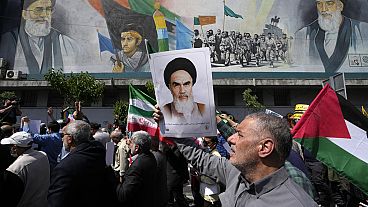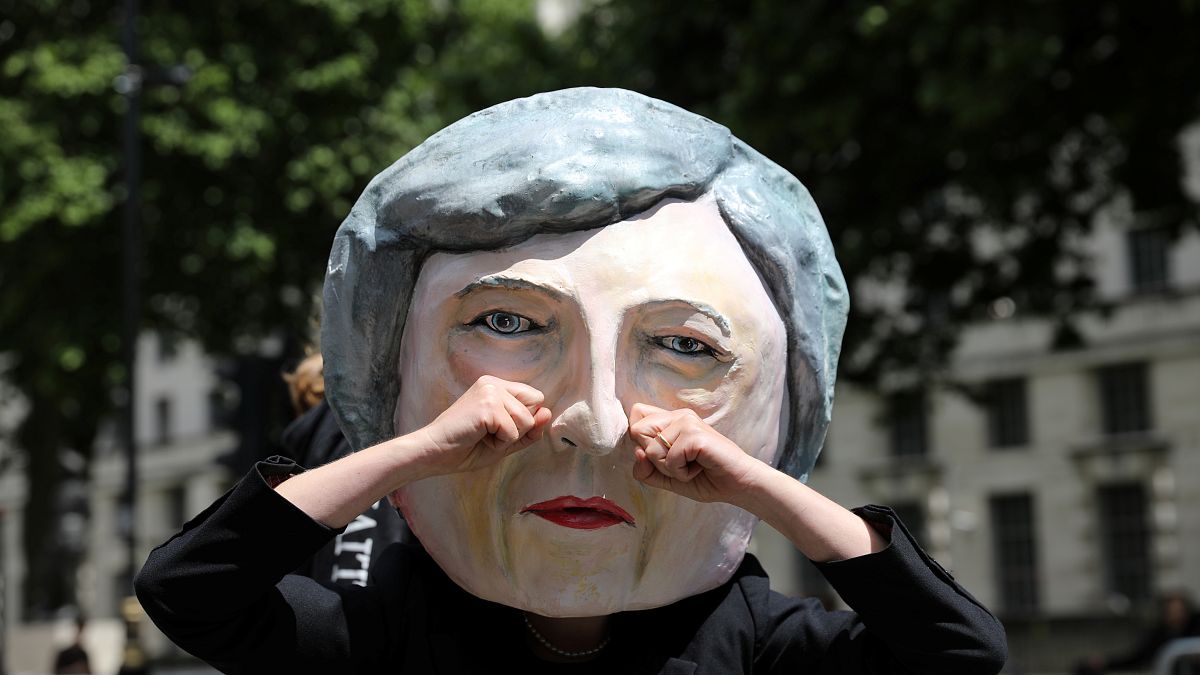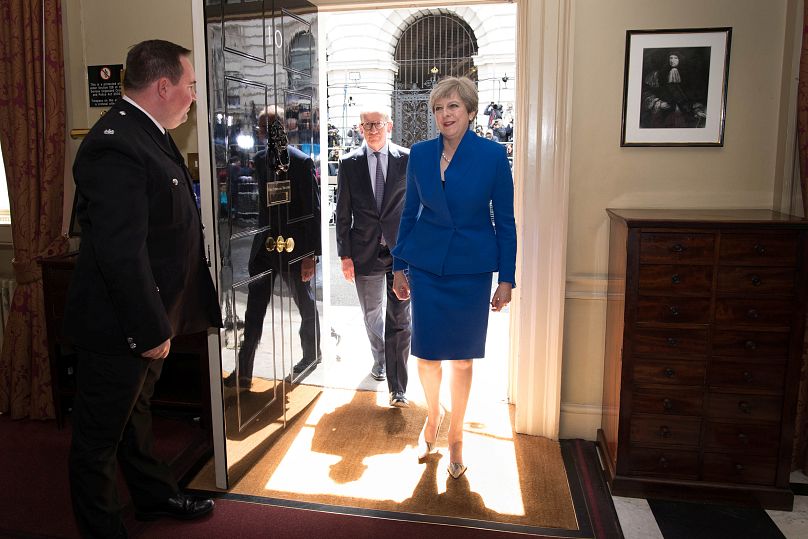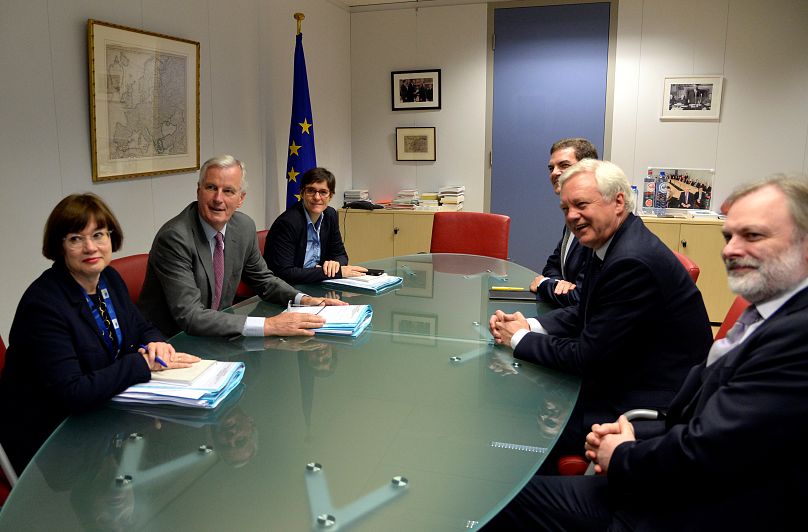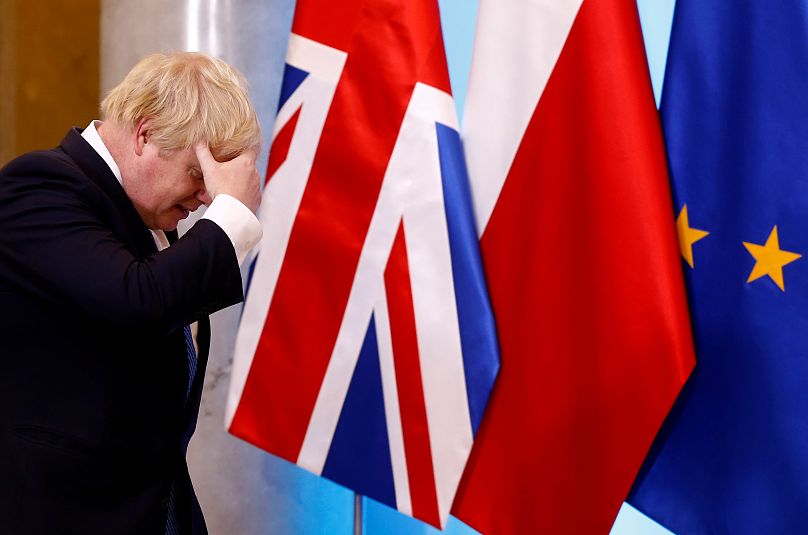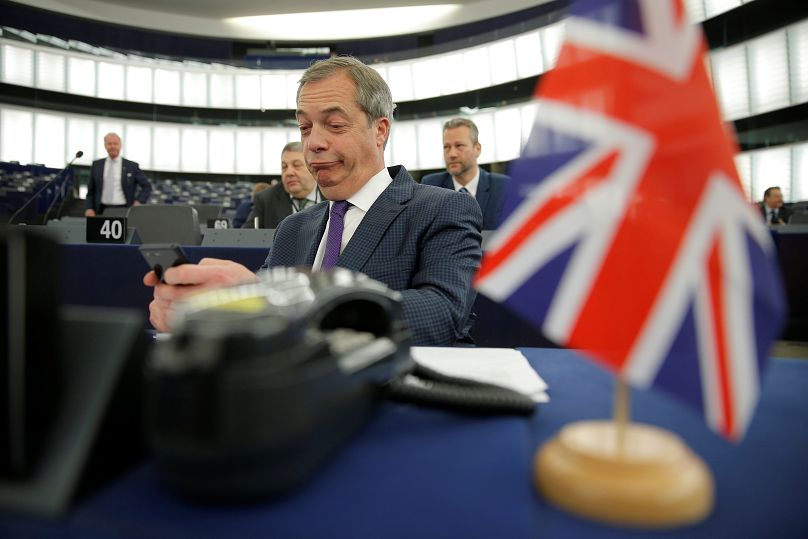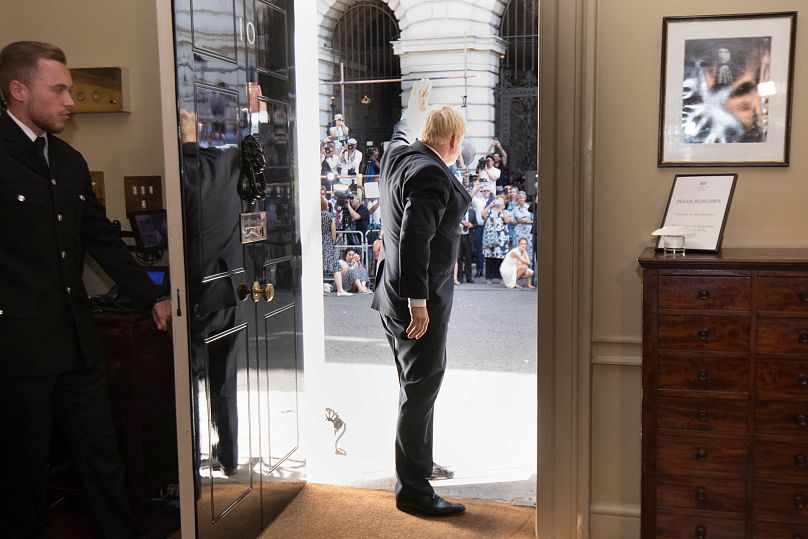How Britain launched the Brexit process after the 2016 referendum, but has since failed to find the exit door.
The United Kingdom was due to leave the European Union at the end of March – but amid bitter division and political chaos has failed to find the exit door.
Previous reports in this series have examined the history of the UK’s troubled relations with Europe: the first from its entry in 1973 and through the Thatcher years; the second as the 1990s brought closer integration; the third as EU expansion and rising Euroscepticism brought tensions to a head; and the fourth on the tumultuous events before and after the 2016 referendum.
Here we look at the key events since the UK triggered the formal exit process, as tense negotiations between London and Brussels eventually resulted in a deal – only for British political turmoil to force Brexit to be delayed and another prime minister to fall.
April 2017: May gets trigger-happy
The previous month has seen British Prime Minister Theresa May fire the starting pistol for the UK’s exit from the EU, invoking Article 50 of the Lisbon Treaty to set in motion the formal Brexit process. It sets the exit date for two years ahead: March 29, 2019.
Now she seeks to bolster her government for the parliamentary battles ahead. On April 18, unexpectedly she calls a snap general election, looking to take advantage of positive opinion polls to strengthen the Conservatives’ grip in the House of Commons.
The decision backfires drastically. After a disastrous campaign, and a strong performance by Labour leader Jeremy Corbyn, the Tories lose their majority. May is forced to do a deal with the tiny Northern Irish unionist party the DUP to stay in power. The outcome leaves her severely weakened and will have a major impact on how Brexit unfolds.
Brussels takes control
In contrast to ongoing divisions in the UK, the EU has maintained a largely united front over Brexit. The European Commission – mandated by EU leaders to conduct negotiations under (former Commissioner and French government minister) Michel Barnier – sets out the sequencing and parameters of the future talks.
Key issues to be settled have already been established the previous year: the UK’s exit bill, the rights of EU citizens living in the UK and Britons on the continent, and the future border between Ireland – in the EU – and Northern Ireland, which as part of the UK will be outside the bloc. These divorce items will be followed by negotiations on future relations including trade.
The aim is to secure a deal in good time for ratification by member states and British and European parliaments. By the summer of 2017 the Commission has published several “position papers” setting out the EU’s negotiating stance.
From ‘go whistle’ … to ‘we’ll pay up’
Brexit talks get underway properly in July, but the UK side is accused of being in disarray. An official photo shows each member of Barnier’s team with a full dossier of papers, while on the other side of the table the British negotiators clasp their empty hands.
The previous week another of Brexit’s leading lights does his bit for constructive diplomacy: Foreign Secretary Boris Johnson agrees with a colleague in the House of Commons that the EU can “go whistle” for its money over the exit bill. Barnier responds to say he hears no whistling, “just the clock ticking”.
As pressure builds to make progress in the talks, Theresa May uses a major speech in Florence in September to reassure the EU that the UK will “honour commitments” over the European budget.
Daylight in December, but red lines change colour
After weeks of deadlock, the EU and the UK announce a dramatic breakthrough on December 8 following an overnight dash to Brussels by Theresa May. The agreement on the divorce terms paves the way for negotiations to move onto trade and future relations.
The deal is widely welcomed but citizens’ rights groups condemn a “grubby bargain” that sells them short, and a lack of detail in guarantees given over the Irish border brings suspicions the issue has been fudged.
“This is not a deal, it’s a capitulation,” says ex-UKIP leader Nigel Farage, one of the main driving forces behind the Brexit vote. His words will come to be echoed by many a Conservative Brexiteer a year later when the final agreement runs aground in the Commons.
In March 2018 the UK and EU agree terms on a transition period following Brexit to run to December 2020, and a draft legal document to consolidate the Irish border plan. But at the halfway post to Brexit day, London has made more concessions than Brussels.
READ: Article 50 a year on: Brexit 'red lines' change colour
READ: Brexit update: 2 years after the referendum
No checkmate at Chequers – instead the dominoes fall
Summer 2018: two years on from the referendum, over a year since Article 50 was triggered, and the British government is still divided over Brexit’s future shape.
In early July, less than nine months before the UK is due to leave the EU, Theresa May force-feeds her plan to the cabinet at the prime minister’s Chequers country retreat.
The plan offers a much softer version of Brexit than many believe was earlier promised. A “common rulebook” for goods will see the UK stick to EU rules, the European Court of Justice (ECJ) will maintain a key role in arbitration, and a complicated fix on the Irish border envisages the UK collecting tariffs for the EU.
Davis resigns in protest, followed by Johnson and several others. By the end of the year May will have lost 18 ministers over Brexit. Most oppose the Chequers plan – and subsequent deal with Brussels – over its proposed “backstop” arrangement to avoid a hard border in Ireland, arguing it compromises UK independence.
The EU is also nonplussed over the Chequers plan, considering the tariff plan illegal and the Irish border proposal unworkable. May gets the cold shoulder at a summit in Salzburg. European Council President Donald Tusk posts a photo on social media mocking the UK’s Brexit stance: “A piece of cake, perhaps?” it asks. “Sorry, no cherries.” The UK has long been warned against trying to “cherry-pick” EU advantages without the obligations, and trying to “have its cake and eat it”.
READ: What went wrong with Theresa May's Chequers plan?
A deal is done, a hornet’s nest stirred
In the autumn May adapts her plan to include an all-UK customs union with the EU, to resolve the backstop conundrum. Eventually, London and Brussels agree the UK’s exit terms in a 585-page Withdrawal Agreement, and a non-binding Political Declaration on future ties. The deal is signed off by leaders of all EU member states at a summit in late November.
Relief is short-lived. The agreement causes havoc in the House of Commons, and more torment for Theresa May. Brexit opponents and the Labour Party believe it will leave the UK worse off; Eurosceptics argue it binds the UK to EU rules and influence, compromising independence into the future. For many, the "backstop" proposal to guarantee an open border in Ireland is impossible to swallow.
Opposition among Conservative MPs is so strong that May postpones parliament’s “meaningful vote” – which in turn provokes an internal challenge to her leadership.
The prime minister survives this vote, but fails to unite her party behind her deal. In early 2019 no fewer than three votes in the Commons – one in January and two in March – bring together an unlikely alliance of Brexit supporters and opponents, who reject the agreement by emphatic margins.
But most MPs also oppose leaving the EU without a deal. They vote to reject a no-deal Brexit and force the government to seek a delay. Twice, EU leaders agree at special summits to extend British membership – but impose their own deadline. The UK is now due to leave at Halloween: October 31.
The move buys time for both sides – but prolongs uncertainty described as “crippling” by citizens’ rights campaigners.
READ: Brexit delay: does the extension to October change anything?
READ: What's in Theresa May's deal and why is it so unpopular?
In detail: Brexit’s month of turmoil
- March 12, 2019: the EU withdrawal deal suffers a second resounding defeat by 149 votes in the House of Commons. In the first vote in January the government lost by a record margin of 230.
- March 13: MPs vote to reject a no-deal Brexit from happening under any circumstances. In one of the two votes, several government ministers defy orders to keep a no-deal option on the table.
- March 14: MPs back the government to ask the EU to a delay Brexit until June 30, if parliament passes the exit deal.
- March 18: House of Commons Speaker John Bercow rules out a third vote on the Brexit deal, barring substantial changes.
- March 19: EU's chief Brexit negotiator Michel Barnier calls on the bloc to "finalise all preparations for a no-deal scenario".
- March 20: UK PM Theresa May asks the EU to extend the Brexit deadline from March 29 until June 30. She later angers MPs by accusing parliament of playing "political games".
- March 21: EU leaders meet for a European Council summit and offer the UK two alternative Brexit extensions, both shorter than the UK's request: May 22 if the deal is passed, April 12 if it is not.
- March 23: hundreds of thousands of pro-EU protesters march in London to demand a second referendum.
- March 25: the European Commission says it is "increasingly likely" that the UK will leave the EU with no deal, and announces it has completed its "no-deal" preparations. UK MPs pass an amendment to a Brexit motion enabling them to seize control of the House of Commons agenda, paving the way for alternatives to the government's Brexit deal to be considered.
- March 27: MPs hold a first round of "indicative votes" on a range of different Brexit models, but it fails to produce a majority for any. Prime Minister Theresa May says she is willing to step down if parliament passes her deal.
- March 29: the House of Commons votes for a third time on the exit deal — but only on the Withdrawal Agreement, not the Political Declaration. It brings a third defeat for the government, this time by 58 votes.
- March 31: a petition calling on the UK government to stop Brexit and remain in the EU, by revoking the formal process under Article 50, has now received more than six million signatures.
- April 1: MPs hold more indicative votes but all four options are defeated.
- April 2: after a long crisis meeting with her divided Cabinet, Theresa May says she will seek to work with Jeremy Corbyn to secure a compromise Brexit deal — a major shift in strategy which angers many Brexit supporters.
- April 2: earlier in the day EU chief negotiator Michel Barnier warns "no deal" is increasingly likely, while French President Emmanuel Macron says the EU cannot be held "hostage" to the UK's "political crisis".
- April 3: May holds talks with Corbyn who describes them a "useful but inconclusive". Two junior ministers quit in protest at May's strategy. MPs pass a bill from Labour's Yvette Cooper by just one vote to force the prime minister to seek a further delay to stop a no-deal Brexit.
- April 4: Ireland's Prime Minister Leo Varadkar hosts Angela Merkel in Dublin. The German Chancellor pledges "major efforts to avoid a hard Brexit".
- April 5: UK Prime Minister Theresa May requests another delay to Brexit, this time until June 30, opening up the possibility of Britain taking part in the European Parliament elections in late May.
- April 6/7: May defends the compromise talks with Labour amid reports of scant progress. Eighty Labour MPs write to Corbyn to demand he insist on a second referendum.
- April 8: the Cooper bill designed to block a no-deal Brexit passes the House of Lords and becomes law. Government talks with Labour appear to be going nowhere.
- April 9: May visits Merkel in Berlin and Macron in Paris. British MPs endorse her request to delay Brexit until the end of June. European Council President Donald Tusk invites EU leaders to consider a "flexible" extension of up to a year.
- April 10/11: At a special European Council summit on Brexit, EU leaders approve a "flexible extension" of the UK's membership until October 31. It can be cut short if the withdrawal deal is passed. Otherwise, the UK retains full membership rights and obligations.
May’s fate sealed in May
The month of May brings a drubbing for the UK’s two main parties at the polls. At local and European elections – which the UK is forced to contest as an ongoing EU member – voters punish both the Conservatives and Labour, long accused of ambiguity over Brexit.
The failure to “deliver Brexit” prompts an insurgency among “leave” supporters. A new Brexit Party, founded by former UKIP leader Nigel Farage and advocating no-deal, storms to victory in the European vote. But there is also a strong showing from pro-EU parties, in particular the Liberal Democrats.
By this time Theresa May has announced she will stand down as Conservative leader in June, and as prime minister once a new leader is chosen.
The move creates yet more uncertainty over Brexit’s direction and revives fears in Europe of a no-deal exit.
READ: Brexit vs. Remain: Who really won the European elections?
READ: What's the secret of Nigel Farage's success and what's his Brexit plan?
My no-deal’s better than yours
The Tory leadership race opens in June with a series of votes of party MPs to whittle down the numerous candidates. No fewer than ten have thrown their hat into the ring.
Some contenders for leader, including frontrunner Boris Johnson, vaunt their no-deal credentials. Others put forward a more nuanced stance, while at least two actively oppose an outcome many economists and business groups warn would be catastrophic.
One of those resisting a no-deal Brexit, Rory Stewart — a loyal minister under Theresa May — survives two early rounds before being eliminated. He is followed out by home secretary Sajid Javid, and environment minister Michael Gove, a leading Brexit campaigner in the 2016 referendum.
This leaves the final two, who are to be put to a postal ballot of Conservative members. Foreign secretary Jeremy Hunt narrowly survives the cut to face Boris Johnson — his predecessor in the post who led the "Leave" campaign in the 2016 referendum is the arch favourite, having finished each round of voting far ahead of the rest of the field.
READ: As Brexit looms, the UK Conservative Party fights for survival
Many in the party favour leaving the EU without a deal and have backed the Brexit Party at the European elections. A YouGov survey of Conservative members finds a significant majority want Brexit to happen even if it means the United Kingdom loses Scotland and Northern Ireland, suffers significant damage to the economy, and the Tory party itself is destroyed.
The result is announced on July 23. The former London mayor wins 92,163 votes to Hunt's 46,656 — 66% of the vote for Johnson, against 34% for Hunt.
The following day, Theresa May formally stands down and her successor enters Downing Street after being received by the Queen at Buckingham Palace.
Alexander Boris de Pfeffel Johnson has fulfilled a lifetime ambition and is the new Prime Minister of the United Kingdom.
'We will leave... no ifs or buts'
The early days of Johnson's premiership see Brexit take on a distinctly harder edge, raising the likelihood that the UK will leave the EU without a withdrawal deal in the autumn. A strongly pro-Brexit cabinet is installed in an unprecedented shake-up of the British government, and plans are duly announced to ramp up no-deal preparations.
Economists, industries and businesses sound more alarm bells about the consequences. In parliament many MPs, even among the ruling Conservatives who only have the slimmest of majorities, vehemently oppose a no-deal Brexit and vow to try to stop it. Speculation grows that the autumn may bring a general election.
The new prime minister is undeterred. His demands that the Irish backstop be ditched from the negotiated agreement are swiftly rebuffed by EU leaders, who have already warned at a June summit that the withdrawal text will not be reopened.
READ: What is the Irish border backstop and why does Boris Johnson want it ditched?
Boris Johnson nevertheless trumpets an optimistic message: a new deal can be struck with the EU, he says, and the odds against a "million to one".
Standing outside Downing Street, he takes on his opponents in his victory speech: "I am standing before you today to tell you, the British people, that those critics are wrong. The doubters, the doomsters, the gloomsters. They are going to get it wrong again."
"The people who bet against Britain are going to lose their shirts because we're going to restore trust in our democracy. And we are going to fulfil the repeated promises of Parliament to the people and come out of the EU on October 31, no ifs or buts."
New UK Prime Minister Boris Johnson: 'I'm convinced we can do a Brexit deal'
No-deal Brexit: everything you need to know
Brexit Guide: where are we now?
A history of UK–EU tension
Check out the rest of our series charting the United Kingdom's complicated relations with the European Union:
- Part 1, 1973-1990: Je t'aime, moi non plus
- Part 2, 1990-2004: I'd do anything for love
- Part 3, 2004-2016: Should I stay or should I go
- Part 4, 2016-2017: I will survive
